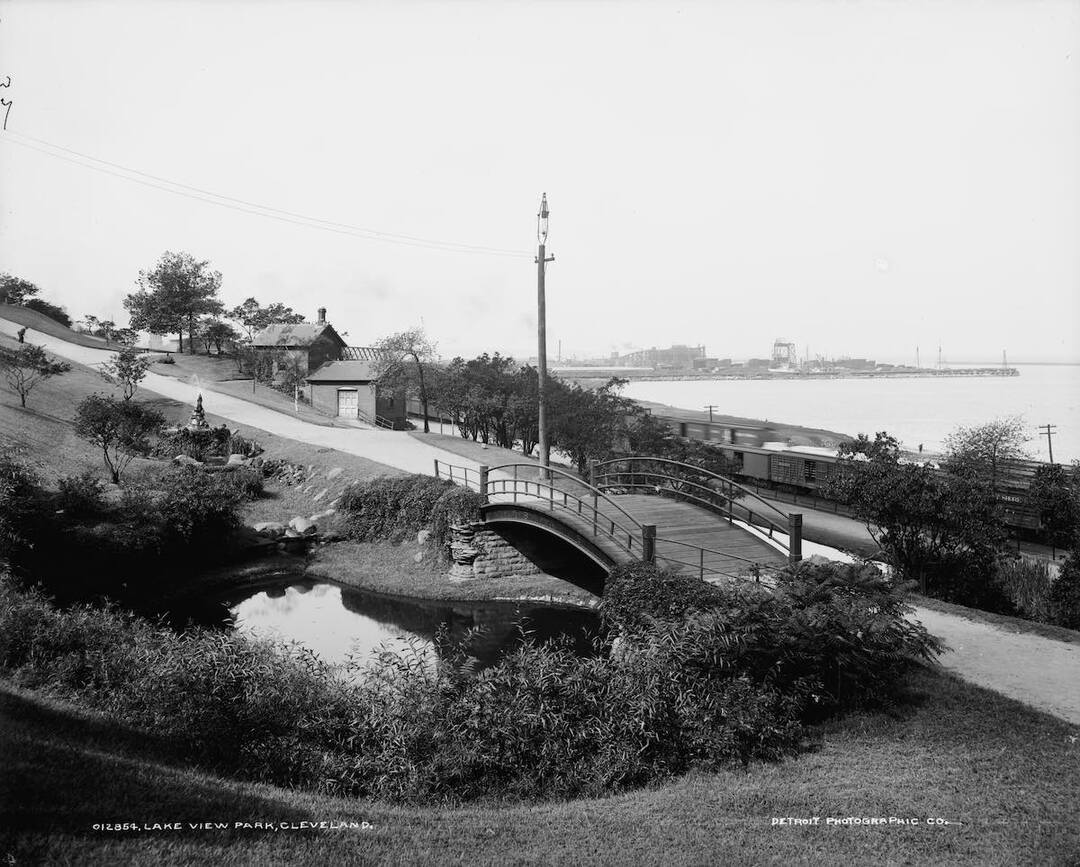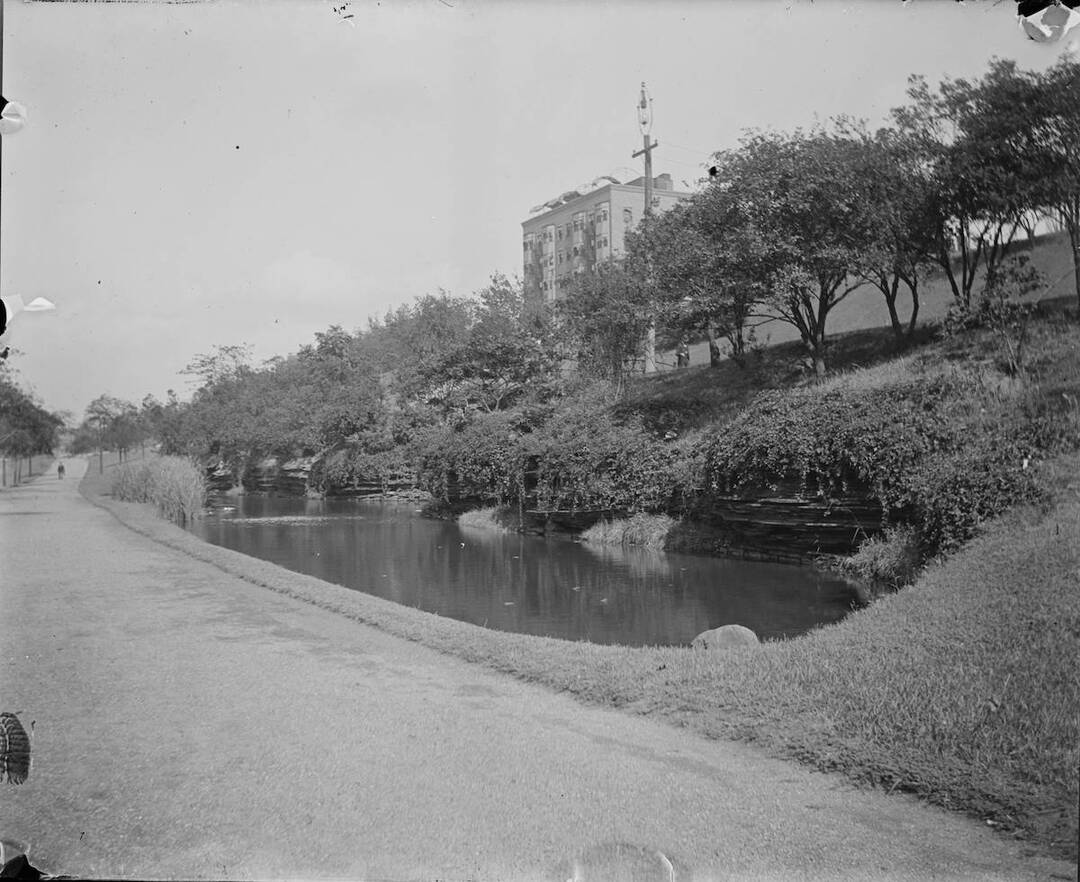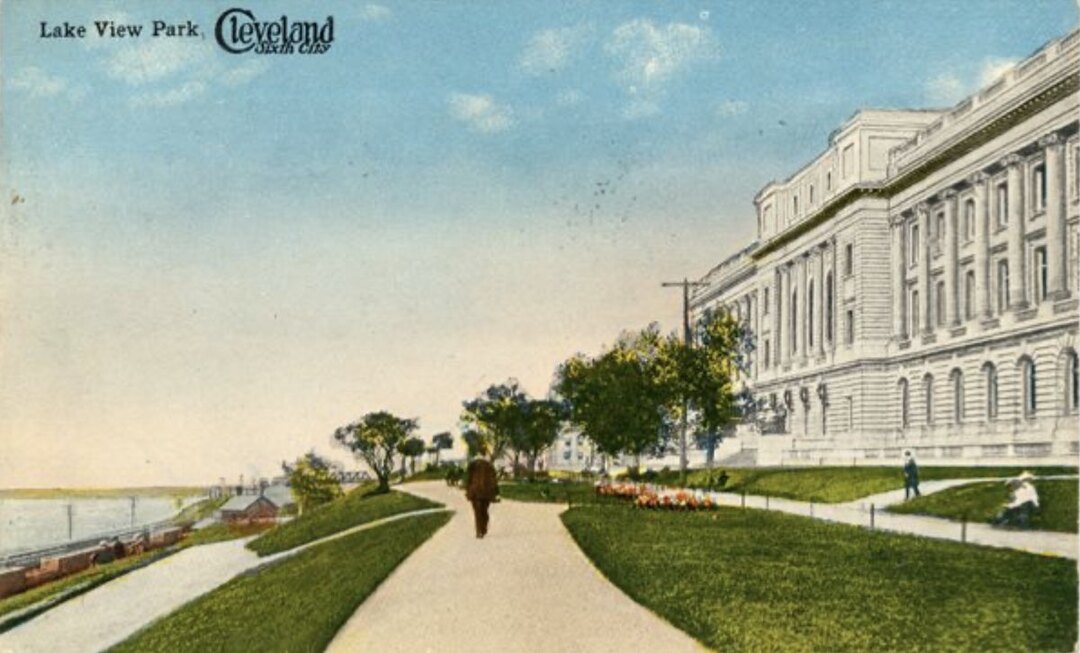
“Lake View Park! How many can remember the view from there, north, east, west far to the horizon of Lake Erie. Sailing vessels would stand along the sky line, jibs and mainsails immovable as in a picture. Down below passenger engines would move on the Lake Shore tracks, with stately shining stacks, deer horns behind the head lights, and flashing flag rods. From your seat under trees along Summit Street you would look again. Those vessels had moved. You could see it. Slowly creeping ahead until past or off Cleveland’s harbor.” —S. J. Kelly, Plain Dealer columnist (1936)
In 1936, Cleveland newspaper columnist S. J. Kelly reminded Clevelanders of the loss of what was once the pride of the Forest City—Lake View Park. The origins of Lake View Park can be traced back to 1867, when a group of citizens visited Mayor Stephen Buhrer to request a lakeside park, leading the city council to recommend acquiring land. In 1869, the Ohio legislature passed a bill that enabled the city council to condemn and purchase land for Cleveland’s first park. Council approved buying property between the lakefront railroad tracks and Summit Street (a street that once ran a block to the north of today’s Lakeside Avenue) from Seneca (W. 3th) to Erie (E. 9th) Streets. In 1871 the mayor appointed the first Board of Park Commissioners, empowering them to levy taxes for park purposes. It took two more years before the land was fully appraised and purchases were completed to assemble ten acres.
In 1874 the park commissioners authorized issuing $50,000 in bonds for park development. The city then removed the shanties along Summit Street and graded and terraced the bluff. Landscape gardener C. T. Shueren devised a plan of improvements. City workers planted trees, sculpted ponds, and created decorative features. Instead of allowing the entirety of Cleveland’s downtown lakefront to be given over to shipping and industrial interests, the city had used its natural resources to its advantage, opening up the first city park as a showcase for the natural beauty of the lakefront. For the 1876 U.S. Centennial, the park offered a favored vantage point for Clevelanders and out-of-towners to watch a “sham” reenactment Commodore Perry’s battle on Lake Erie. Through ongoing beautification work, by 1885, Lake View Park was reportedly a showplace that must have impressed railroad passengers on the Lake Shore & Michigan Southern line that ran past the lower level of the park.
Lake View Park included many pathways which visitors could walk through to observe the gorgeous flower fields, rock grottos, manmade lakes, and unique features such as the large fountain—fashioned in the likeness of what observers variously described as a dinosaur, dragon, or lizard—which stood in the middle of the park grounds. The public reception to Lake View Park was overwhelmingly positive, with many praising the naturalistic environment that was in stark contrast to the dominant industrial and commercial sections of the central city.
Despite the attractiveness of Lake View Park, it was not without its problems. Periodic news reports make clear that by the 1880s, the park already had “acquired a tough reputation.” It was a “rendezvous” for “improper purposes,” “infested by mashers” (a Victorian-era reference to men who sexually harassed women), lined with saloons, and often “virtually deserted.” Given the park’s prime location alongside downtown, existing railroad rights-of-way, and the lake, not to mention the problems the park faced, the city entertained various proposals from business interests to redevelop the area. One proposal in 1889-90 was for a 10,000-seat exposition hall in the park, which it was held would rival similar venues in Detroit and Pittsburgh as a tourist attraction. However, iron and steel interests hoped eventually to expand the industrial usage of the lakefront, and some city officials decried the loss of Cleveland’s only central park on the lake. Ultimately the plan was dropped.
External pressure from rising industrial powers to replace Lake View Park would be enough for most local governments to consider the offers, especially with the promise of a future economic boom. However, Cleveland officials and citizens regularly pushed back against threats to close the park. Citizens formed committees and brought petitions to court to protect Lake View Park, and the local government regularly hosted events on park grounds to show that interest was still high. However, industrialists’ interest in the lakefront was unmoved by citizen interest in public access to the waterfront. Therefore, it came as little surprise that, in 1907, a new union railroad depot was approved for the Lake View Park site as part of the Group Plan. The station plan, however, met with severe backlash in 1910 from park supporters, who argued that the establishment of a railroad depot was antithetical to the very reason that Lake View Park was established and offered a less-people-friendly experience to visitors. Despite grievances from the public, city officials viewed the union depot as far too important to reject. Only the federal government’s concern during World War I about local rail traffic impeding cross-country traffic along the lakefront lines prevented the lakefront union station from reaching fruition.
Nevertheless, even as the debate over building a union depot raged, the decline of Lake View Park became apparent and too rapid to stop. The worsening pollution caused by the aforementioned railroad, as well as the numerous factories established through the city, suffocated the natural life in the park. The park’s trees and flowers began to wilt and die and its manmade lakes, which were once a beautiful highlight, became toxic and polluted. Despite preventing industrial society from directly destroying Lake View Park, the city was unable to stop the negative effects that industrialism had on the environment, which destroyed the park all the same.
The effect that pollution had on Lake View Park led to a further drop in attendance, but the park’s end did not come right away. Instead, as is usually the case with redevelopment, it awaited a firm plan that could make it off the drawing board. That firm plan came in early in the 1930s, soon after construction of the multipurpose Cleveland Municipal Stadium, when the city built an underground garage for nearby City Hall. By that time, “made land” (or fill) had shifted the water's edge some 1,000 feet to the north, making the “lake view” a more distant one. Ever an astute observer of Cleveland’s changing cityscape, Plain Dealer columnist S. J. Kelly noted that the dragon fountain, once the park’s conversation piece, was headless by that time and carried off by a junk dealer.
Despite efforts from citizens and local city planners, this beautiful and unique landmark which afforded a place to marvel at the majesty of one of the Great Lakes was allowed to waste away until its final demise went unmourned. Clevelanders today have no memory of Lake View Park, which has been buried beneath parking garages for nearly a century. Lake View Park was a final bastion of naturalist beauty and appreciation along a Cleveland downtown lakefront dominated by capital interests. With its demise, officials, planners, and citizens would struggle for the next century to give Clevelanders a people-friendly lakefront.
Images








